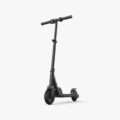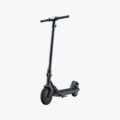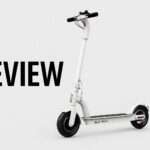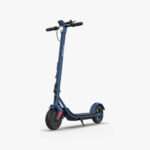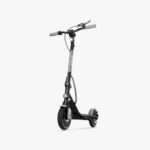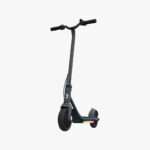- Home
- Scooters
- Electric Scooters
- Jetson Canyon
Jetson Canyon
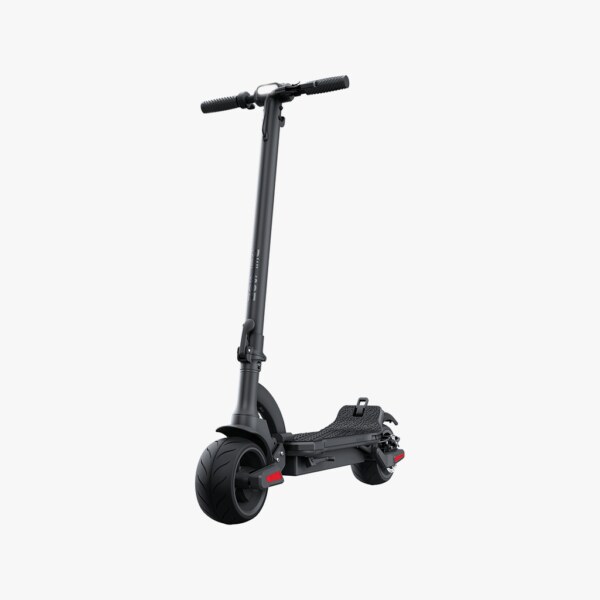


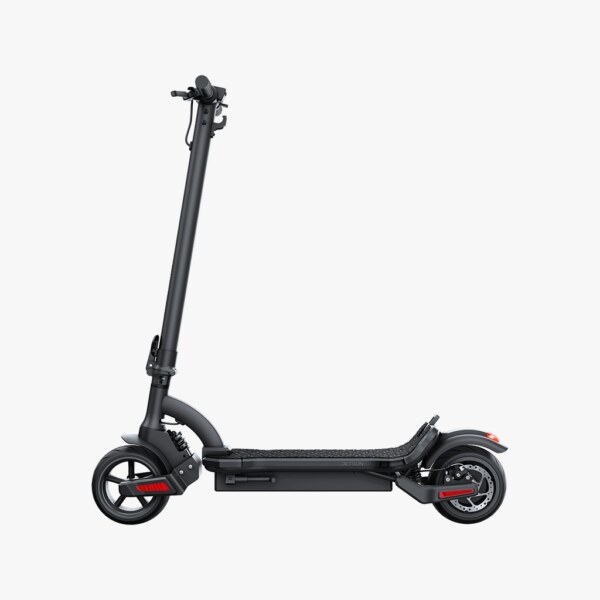
- Battery Range: 22 miles (35.4 km)
- Top Speed: 15.5 mph (25.0 km/h)
- Motor Power: 500 W
- Weight Capacity: 265 lb (120.2 kg)
- Charging Time: Approx. 6 hours
- Scooter Weight: 62.0 lb (28.1 kg)
PROS
- 500 W motor with 48 V system for stronger torque
- 22 mile (35.4 km) claimed range for longer commutes
- Three speed settings via LCD for controlled riding
- Solid 8.5 in tires remove puncture risk
- Sturdy 265 lb (120.2 kg) load rating
CONS
- Heavy 62 lb (28.1 kg) frame reduces portability
- Solid tires and no suspension limit comfort
- Top speed limited to 15.5 mph (25.0 km/h)
- No clear regenerative braking or app integration detailed

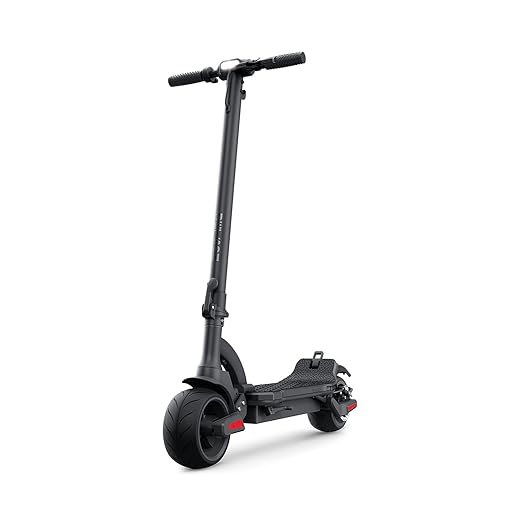
Key Takeaways
- The Jetson Canyon is a versatile folding electric scooter with a 500W motor, supporting up to 265 lb and speeds up to 15.5 mph.
- It features solid 8.5 inch tires and front and rear suspension for a stable ride, making it ideal for short to medium commutes.
- With a range of up to 22 miles, the Jetson Canyon suits daily routines, especially for urban commuting.
- It comes with multiple speed modes and cruise control for new riders to build confidence and comfort.
- However, it’s relatively heavy at 62 lb, making it less ideal for frequent lifting or stair usage.
Table of contents
- What Is the Jetson Canyon?
- How the Jetson Canyon Works
- Key Specifications
- Design & Build Quality
- Performance Fundamentals
- Battery, Range & Efficiency
- Ride Quality & Comfort
- Braking & Safety Features
- Portability & Daily Usability
- Maintenance & Care
- Weather & Seasonal Considerations
- Jetson Canyon vs Alternatives
- Who the Jetson Canyon Is (and Isn’t) For
The Jetson Canyon is a folding electric scooter made for real life, not just spec sheets. It suits teens and adults who want steady power, solid build, and simple controls without chasing wild top speeds. So this guide walks through what it is, how it rides, and whether it fits your daily routines.
What Is the Jetson Canyon?
The Jetson Canyon runs a 500W rear hub motor on a 48V lithium ion system. It reaches up to 15.5 mph (25 km/h) and supports riders up to 265 lb (120 kg). So it sits above tiny starter scooters and feels closer to a compact commuter tool.
It rolls on 8.5 in solid tires, with front and rear suspension, a rear disc brake, and a folding stem. The deck is long enough for a relaxed stance, and the scooter weighs about 62 lb (28.1 kg). That weight makes it feel planted at speed, even if it is not the easiest thing to carry. The claimed range of up to 22 mi (35 km) puts it in a practical zone for short to medium trips.
How the Jetson Canyon Works
The system is simple once you see it in action.
You press the thumb throttle. Then the signal goes to the controller inside the deck. The controller draws power from the 48V battery and feeds the 500W rear hub motor. More throttle means more push, so the scooter eases you up to speed without drama.
When you roll off the throttle, power backs off smoothly. Three riding modes limit response and top speed. That setup helps new riders start slow, build trust, and move up when they feel ready.
A hand lever on the bar controls the rear mechanical disc brake. A light pull trims speed. A firm pull gives strong bite for short, controlled stops. If you used bicycle brakes before, this feels familiar.
In the center, the display shows speed, battery bars, and mode. Buttons close by handle lights and mode changes. Cruise control kicks in after you hold a steady throttle for a bit, then turns off as soon as you tap the brake or move the throttle. So long, flat stretches feel easier on your thumb.
Key Specifications
Here are the core specifications in a clean view, so you can match numbers to your needs.
| Category | Details |
|---|---|
| General | Model: Jetson Canyon • Recommended age: 12+ • Max rider weight: 265 lb (120 kg) |
| Performance & Power | Motor: 500W rear hub • Top speed: up to 15.5 mph (25 km/h) • Claimed max range: up to 22 mi (35 km) • Multiple speed modes |
| Battery, Charging & Electrical | Battery: 48V 10Ah lithium ion • Approx 480Wh • Charge time: up to about 6 hours • Charger: 54.6V output • Integrated LCD display |
| Build & Dimensions | Tires: 8.5 in solid • Front and rear suspension • Weight: about 62 lb (28.1 kg) • Unfolded: about 44.5 x 18.5 x 49.2 in (113 x 47 x 125 cm) • Folded: about 44.5 x 18.5 x 18.9 in (113 x 47 x 48 cm) |
| Safety & Control | Rear disc brake • Front and rear lights • Side reflectors • Bell • Speed modes |
| Features & Extras | Cruise control • Kickstand • Foldable stem • Simple cockpit layout |
| Warranty & Compliance | Limited warranty on main components • Standard consumer compliance markings |
These specifications place the Jetson Canyon in the mid range commuter category, with real support for heavier riders and calm, controlled performance.
Design & Build Quality
The first thing you notice is that the Canyon feels tough. The stem is thick, the folding joint feels tight when locked, and the deck looks dense since it houses both battery and controller. So the scooter gives more “serious gear” vibes than “cheap toy” vibes.
The deck length lets you stand with one foot forward and one back without hanging off the edge. Grip tape and side shaping keep your shoes steady during braking and small bumps.
Up top, the layout stays clean. Thumb throttle on one side, brake lever on the other, display in the middle. Then you get simple buttons near the screen for lights and mode changes. You do not dig through clutter or hidden toggles, which helps when you ride in traffic.
The folding latch has a safety catch that you need to set properly each time. When it clicks in as it should, stem wobble stays low. That detail matters for confidence at full speed, especially on rougher blocks.
Performance Fundamentals
On the street, the Jetson Canyon feels honest.
In the highest mode, it pulls from a stop with more strength than small 250W scooters. So you clear intersections with less stress and blend into bike lanes more easily. It climbs to 15.5 mph (25 km/h) and stays there in a smooth, steady way on flat ground.
On hills around 7–10%, the 500W and 48V combo helps it keep moving where weaker models sag. You still lose speed on longer climbs, yet you do not feel helpless. For short ramps, bridge approaches, or rolling neighborhoods, it holds its own.
Straight line stability is one of its strong points. The weight in the deck and the geometry work together, so the scooter tracks straight instead of twitching with every small movement. That calm feel helps new riders loosen their grip and ride more naturally.
This is not a racing scooter. It is built to feel predictable, repeatable, and safe at its capped speed, and it hits that target.
Battery, Range & Efficiency
The Jetson Canyon runs a 48V 10Ah pack, close to 480Wh. On paper, that lines up with the claim of up to 22 mi (35 km) in very light use. In the real world, the story shifts with your weight, speed, route, and weather.
A lighter rider around 130 lb (59 kg) in lower modes on flat bike paths stands the best chance to approach the claim. An average rider around 170–190 lb (77–86 kg) who likes top mode, stops often, and hits a few hills will see less, yet still enough for most daily trips. A heavier rider near 265 lb (120 kg) using full power often should plan on shorter distances.
You can stretch range and protect the battery with small habits.
Charge soon after rides instead of parking it empty. Try not to drain it all the way down every time. Store the scooter indoors, away from extreme heat or cold. Let a very cold pack warm up toward room temperature before you plug in. So you keep performance more consistent over time.
Ride Quality & Comfort
The Canyon uses solid 8.5 in tires plus front and rear suspension. That combo aims to cut out flats and still take the edge off rough ground.
On smooth asphalt or clean bike lanes, the ride feels calm and stable. The suspension softens joints, shallow cracks, and minor bumps. So for many city routes, comfort lands in a nice middle ground.
On broken pavement, brick, or patched sidewalks, you feel more of the sharp hits than you would with large pneumatic tires. The springs do help, just not in a magic way. If you keep your knees relaxed and shift your weight a bit over rough spots, the scooter stays controlled and fairly kind.
Stem flex stays low with a properly locked latch. That detail keeps steering precise enough without feeling nervous. Bar height suits many teens and adults. The deck supports a natural stance that works for short hops and full battery runs.
Braking & Safety Features
Braking is handled by a rear mechanical disc brake. When set up well, it matches the speed and weight of the scooter.
A light squeeze trims speed with control. A firmer pull brings strong stopping power for quick situations. After a few test stops in an open space, most riders get a clear sense of how much pull they need.
The Canyon comes with front and rear lights. Turn them on in dim light, even during early mornings or cloudy afternoons. Side reflectors support visibility from more angles. There is a bell for signaling in shared spaces.
Water exposure stays a weak spot. The design does not push deep sealing, so treat heavy rain, deep puddles, and hose spray as things to avoid. A good helmet, clear spacing from cars, and steady braking habits do more for your safety than hidden tech.
Portability & Daily Usability
The fold is quick. The weight is not.
You flip the latch, fold the stem down, and lock it. Then the Jetson Canyon becomes a compact block that fits in many trunks, hallways, and office corners. For car commuters or people with ground level storage, that shape works well.
At around 62 lb (28.1 kg), carrying tells a different story. Short lifts over a curb, into a car, or up a few steps are fine for many people. Long stair runs or constant lifting through stations feel rough. If you live on a higher floor without an elevator, this scooter turns into a workout fast.
For daily use, it shines when you can roll more than you lift.
Keep it in a garage, by the door, or in a building with elevator access. Use a strong lock through the frame and wheel for quick stops. Bring it inside overnight for both security and battery care. So it becomes an easy part of your routine instead of a burden.
Maintenance & Care
Keeping the Jetson Canyon in shape is simple if you stay a bit consistent.
Before each ride
Check the brake lever. It should start to grab before it hits the grip. Make sure the folding latch and safety catch are fully locked. Power it on, glance at the display, and test the lights. Listen for new rattles.
Weekly
Look over stem and handlebar bolts. Tighten light movement with the included tool. Wipe dust, grit, and moisture off the deck and folding areas. Check the solid tires for cuts or sharp objects.
Monthly
Inspect brake pads and rotor. If stopping feels soft or the lever pulls too far, adjust cable tension or let a shop tune it. Check the suspension mounts for any play.
Every few months
Check axle nuts, spring mounts, and visible fasteners. Clean around the charging port with a dry cloth. Keep connectors closed and dry when not in use.
Use a damp cloth and mild soap for cleaning. Skip pressure washers, harsh chemicals, and soaking. Then the scooter stays tight, safe, and ready.
Weather & Seasonal Considerations
The Jetson Canyon does its best work in dry weather.
In light rain, grip drops, especially on paint, metal covers, or leaves. So slow down, keep inputs smooth, and give yourself more room to brake. Deep puddles and heavy showers raise risk for both traction and electronics, so avoid them when you can.
Cold weather cuts range. The battery gives less energy when cold. Store the scooter indoors, start rides with a warm pack, and expect fewer miles than on warm days. Let the scooter warm up first if it has been sitting in freezing air.
Hot days can stress the battery. Try not to leave it baking in a closed car or full sun for long hours. Shade and indoor storage help a lot.
No matter the season, run lights in low visibility, ride within what the surface allows, and dry the scooter after it gets wet.
Jetson Canyon vs Alternatives
The Canyon lands between tiny last mile scooters and bulkier high speed machines.
Compared with small 250–350W scooters, it offers stronger drive, higher weight support, and a sturdier feel. So heavier riders and longer urban trips sit more in its comfort zone.
Compared with ultra light models, it loses on carrying ease. Those lighter scooters win in stairs, tight transit changes, and quick lifts.
Compared with big dual motor or large tire scooters, the Canyon is slower, slimmer, and much simpler. It does not chase aggressive top speeds or off road fun. Instead it focuses on calm, capped speed for paved routes and regular riders.
If you want a more playful and sport focused option from the same brand, the Jetson Racer offers a different feel. If you prefer a simpler and lighter folding scooter style, the Jetson Eris sits closer to classic last mile use.
So if you want a real commuter scooter without going into heavy motorcycle vibes, the Jetson Canyon fits that gap.
Who the Jetson Canyon Is (and Isn’t) For
You can decide fast by matching your habits to its strengths.
Best for
- Commuters with daily round trips up to about 8–10 mi on paved roads or paths.
- Students who ride across campus and store indoors.
- Riders up to 265 lb who want stronger pull than small scooters give.
- New and intermediate users who like clear modes, cruise control, and a stable feel.
- Owners with garage, hallway, or elevator access who rarely carry a scooter upstairs.
Not ideal for
- People who need a very light scooter for constant lifting, tight trains, or long stairs.
- Speed fans chasing 25–35 mph, dual motors, and big hydraulic brakes.
- Off road riders who want knobby tires, big travel, and extra clearance.
- Daily heavy rain riders who need strong, stated water protection.
If you match the first group more than the second, the Jetson Canyon feels like a solid, honest pick that trades a bit of portability for better support, stability, and real world use.
Specifications
General
| Model The Model specifies the exact version or name of the scooter. It helps identify its unique design, features, and specifications within the manufacturer’s product line. Knowing the model makes it easier to compare options, find compatible accessories, or look up support information. | Canyon Electric Scooter |
| Brand The Brand identifies the manufacturer or company that designs and produces the scooter. A trusted brand is a sign of quality, reliability, and good customer support. Well-known brands often have higher standards for safety, performance, and after-sales service, giving you more confidence in your purchase. | Jetson |
| Release Date The Release Date indicates when the scooter model was officially launched on the market. This helps you know how current the design, technology, and features are. A newer release date often means updated components, improved performance, and the latest safety or smart features. | 18 November 2025 |
| Recommended Age Recommended Age indicates the minimum age range that the scooter is designed for, based on safety, size, and ease of use. Following the recommended age helps ensure that riders can handle the scooter’s speed, weight, and controls comfortably and safely. Always check local laws and use protective gear, especially for younger riders. | 12+ |
Performance & Power
| Motor Power (Wattage) What it means: The motor power, measured in watts (W), shows how strong the scooter’s electric motor is. Why it matters: Higher wattage usually means better acceleration, more torque, and improved performance on hills or rough terrain. For example, a 250W motor is good for flat city roads and light riders, while a 500W or 1000W motor provides more power for faster speeds or climbing steep inclines. | 500 W hub motor |
| Top Speed The Top Speed indicates the maximum speed that the scooter can reach under optimal conditions. It’s usually measured on level ground with a fully charged battery and an average rider weight. A higher top speed allows you to travel longer distances faster, but always ensure you ride within legal speed limits and your personal comfort zone for safety. | 15.5 mph (25.0 km/h) |
| Battery Capacity Battery Capacity refers to the total amount of energy the scooter’s battery can store, usually measured in ampere-hours (Ah) or watt-hours (Wh). A higher battery capacity means you can ride longer distances on a single charge, reducing the need for frequent recharging. Keep in mind that actual range can vary depending on rider weight, terrain, speed, and weather conditions. | 48 V 10 Ah (480 Wh) |
| Estimated Range per Charge The Estimated Range per Charge indicates the average distance the scooter can travel on a single full battery charge. This range is calculated under optimal conditions, such as flat terrain, moderate speed, and average rider weight. Real-world range may vary depending on riding style, terrain, weather, and load. A longer range means fewer recharges and greater freedom for longer trips. | 22 miles (35.4 km) |
| Hill Climb Ability Hill Climb Ability describes the maximum incline or slope that the scooter can handle while maintaining stable performance. It’s typically expressed as a percentage or in degrees. A higher hill climb rating means the scooter can tackle steeper hills without losing too much speed or power. Actual climbing performance may vary based on rider weight, battery charge, and terrain conditions. | 20° |
| Drive System The Drive System refers to how power from the motor is delivered to the wheels. Electric scooters typically use either a hub motor (directly integrated into the wheel) or a chain/belt drive system. A high-quality drive system ensures smooth acceleration, efficient power transfer, and low maintenance. The choice of drive system affects performance, noise level, and overall ride experience. | Not specified |
Charging & Electrical
| Charging Time Charging Time indicates how long it takes to fully recharge the scooter’s battery from empty to 100% using the standard charger provided. Faster charging means less downtime and more time on the road. Actual charging time may vary slightly depending on battery capacity, charger output, and environmental conditions. | Approx. 6 hours |
| Battery Type Battery Type refers to the specific technology used in the scooter’s battery, which affects performance, lifespan, weight, and charging time. Most modern electric scooters use high-quality lithium-ion (Li-ion) batteries because they offer a good balance of energy density, durability, and low maintenance. A reliable battery type ensures consistent power delivery and longer riding ranges. | 48 V 10 Ah lithium-ion battery |
| Removable Battery A Removable Battery means the battery pack can be easily detached from the scooter for convenient charging and replacement. This feature allows you to charge the battery separately, swap it with a spare for extended range, or securely store it indoors in extreme weather. Removable batteries add flexibility and make it easier to keep your scooter powered up wherever you are. | No (internal pack) |
| Regenerative Braking Regenerative Braking is an energy-saving feature that converts some of the energy normally lost during braking back into battery power. When you slow down or brake, the motor works in reverse to generate electricity, which helps extend the scooter’s range and improves overall efficiency. This system also reduces wear on traditional brake components, leading to lower maintenance over time. | Not specified |
| Lighting Lighting refers to the built-in front and rear lights that enhance visibility and safety when riding in low-light conditions or at night. Good lighting helps you see the road ahead and ensures that other road users can see you. Many scooters include LED headlights, taillights, and sometimes brake lights or side reflectors for added safety and compliance with local traffic regulations. | LED headlight and rear light |
Build & Dimensions
| Scooter Weight Scooter Weight refers to the total weight of the scooter when fully assembled, including the battery. This affects how easy it is to carry, lift, and store the scooter when not in use. A lighter scooter is more portable and convenient for commuting, especially if you need to carry it upstairs or onto public transport. Keep in mind that a sturdy frame and quality components may add to the weight but also contribute to better durability and ride stability. | 62.0 lb (28.1 kg) |
| Maximum Rider Weight Maximum Rider Weight indicates the highest rider weight that the scooter is designed to safely support while maintaining optimal performance and stability. Staying within this limit helps ensure reliable acceleration, braking, and climbing ability, and it protects the frame, suspension, and motor from excessive strain. Exceeding the recommended limit may reduce performance and increase wear on components. | 265 lb (120.2 kg) |
| Deck Size Deck Size refers to the dimensions of the scooter’s standing platform. A wider and longer deck provides more foot space, allowing you to stand comfortably and adjust your stance while riding. A well-sized deck improves balance and stability, especially on longer rides or at higher speeds. Compact decks, on the other hand, help keep the scooter lightweight and portable. | Robust folding frame with wide deck |
| Handlebar Height Handlebar Height refers to the distance from the deck to the handlebars, which affects your riding posture and comfort. An appropriate handlebar height helps you maintain good balance, reduces strain on your back and arms, and makes steering more comfortable. Some scooters have adjustable handlebars to fit riders of different heights, while others have a fixed height for a streamlined design. | Fixed |
| Folding Mechanism The Folding Mechanism describes how easily and securely the scooter can be folded for carrying and storage. A well-designed folding system lets you quickly collapse the scooter into a compact size, making it convenient to transport on public transit, store under a desk, or fit into a car trunk. Look for sturdy latches and safety locks to ensure the scooter stays firmly in place when folded or unfolded. | Stem folds via release lever and lock tab |
| Dimensions Folded Dimensions indicate the size of the scooter when it’s fully folded. This measurement shows how much space the scooter will take up when stored or carried, making it easier to check if it will fit in your car trunk, under a desk, or in a closet. Compact folded dimensions are ideal for commuters who need to bring their scooter on public transport or store it in tight spaces. | Unfolded: 44.5 x 18.5 x 49.21 in (113.0 x 47.0 x 125.0 cm); Folded: 44.5 x 18.5 x 18.9 in (113.0 x 47.0 x 48.0 cm) |
| Material Material refers to the primary construction materials used for the scooter’s frame and key components. High-quality materials like aircraft-grade aluminum, reinforced steel, or durable composites provide strength, stability, and a lighter overall weight. A sturdy material ensures the scooter can handle daily wear and tear while maintaining safety and performance. | Aluminum alloy |
Safety & Control
| Brake Type(s) Brake Type(s) describe the braking systems the scooter uses to help you slow down or stop safely. Common brake types include mechanical brakes (like drum or disc brakes), electronic brakes, and foot brakes. Many scooters combine multiple braking systems for added safety and shorter stopping distances. The type and quality of brakes affect your control, especially when riding at higher speeds or on slopes. | Hand-operated braking system (details not fully specified) |
| Suspension Suspension refers to the system that absorbs shocks and vibrations while riding, providing a smoother and more comfortable ride over uneven or rough surfaces. Scooters may have front suspension, rear suspension, or dual suspension for better shock absorption and stability. Good suspension helps reduce rider fatigue and improves control, especially when riding on bumpy roads or off-road paths. | None |
| Tire Type Tire Type refers to the kind of tires the scooter uses, which directly affects ride comfort, traction, and maintenance. Common types include solid (airless) tires, pneumatic (air-filled) tires, or hybrid options. Pneumatic tires offer better shock absorption and a smoother ride on rough surfaces, while solid tires are puncture-proof and require less upkeep. The right tire type helps ensure safe handling and a comfortable ride in different conditions. | 8.5 in solid tires |
| Tire Size Tire Size indicates the diameter and width of the scooter’s tires, which affect ride comfort, stability, and how well the scooter handles different terrains. Larger tires generally offer better shock absorption and a smoother ride over bumps and rough surfaces, while smaller tires keep the scooter lighter and more portable. Choosing the right tire size helps ensure a balance between agility and comfort. | 8.5-inch |
| Kickstand The Kickstand is a built-in stand that allows you to park your scooter upright when it’s not in use. A sturdy kickstand keeps the scooter stable and prevents it from tipping over, protecting it from scratches and damage. It also makes storing and accessing your scooter more convenient, whether you’re at home, work, or on the go. | Side kickstand |
| Water Resistance Rating Water Resistance Rating indicates how well the scooter is protected against water and moisture, usually shown as an IP (Ingress Protection) rating. This rating helps you understand whether the scooter can handle light rain, splashes, or wet roads without damage. While most scooters are not fully waterproof, a good water resistance rating adds peace of mind when riding in changing weather conditions. Always avoid deep puddles or submerging the scooter to protect its electrical components. | Not specified |
Features & Extras
| Display/Console The Display (or Console) shows important real-time information about your ride, helping you monitor your scooter’s status at a glance. Typical displays show speed, battery level, distance traveled, and riding mode. Some models also include additional features like Bluetooth connectivity, app integration, or backlighting for better visibility at night. A clear and easy-to-read display enhances safety and convenience on every trip. | LCD display with speed and battery indicators |
| Ride Modes Ride Modes refer to the different speed and power settings you can choose to match your riding style or road conditions. Common modes include eco for maximum range and energy efficiency, standard for everyday balance, and sport or turbo for higher speed and stronger acceleration. Switching between ride modes allows you to customize performance, conserve battery, and ride safely in various environments. | Three speed modes selectable from handlebar display |
| Smart App Connectivity Smart App Connectivity lets you pair your scooter with a dedicated mobile app via Bluetooth. Using the app, you can monitor real-time ride stats like speed, battery level, and range, adjust settings such as ride modes or cruise control, lock the scooter for added security, and sometimes receive firmware updates. This feature adds convenience and allows you to personalize your riding experience right from your smartphone. | No dedicated smartphone app documented |
| Anti-Theft System The Anti-Theft System helps protect your scooter from unauthorized use or theft. This feature can include built-in alarms, electronic motor locks, GPS tracking, or remote locking through a mobile app. A good anti-theft system provides peace of mind when parking your scooter in public spaces, adding an extra layer of security to safeguard your investment. | Standard power button controls |
| Cruise Control Cruise Control allows you to maintain a steady speed without continuously holding the throttle. This feature makes longer rides more comfortable by reducing hand fatigue and providing a smoother, more relaxed riding experience — especially on flat, open roads or bike lanes. For safety, cruise control can usually be easily activated or deactivated while riding. | Not specified |
| Accessories Included Accessories Included lists the additional items that come with the scooter to enhance your riding experience and convenience. Common accessories may include a charger, kickstand, bell, lights, phone holder, or carrying strap. These extras add value by making your scooter safer, easier to use, and ready to ride straight out of the box. | Scooter, charger, user manual |
Warranty & Compliance
| Warranty Period The Warranty Period indicates how long the manufacturer guarantees the scooter against defects in materials and workmanship under normal use. A good warranty provides peace of mind, showing the brand’s confidence in its product quality. Always check what parts are covered, such as the frame, battery, and motor, and follow the maintenance guidelines to keep your warranty valid. | 12 months limited (see Jetson warranty policy, region-dependent) |
| Certifications Certifications confirm that the scooter meets specific safety, quality, and environmental standards set by recognized organizations or regulatory bodies. Common certifications may include CE, RoHS, UL, or other local compliance marks, depending on your region. These certifications ensure that the scooter is manufactured to high standards and is safe and legal to use in your country. | Conforms to local micromobility regulations where applicable |
Price Comparison




